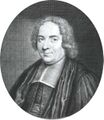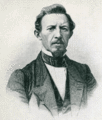Template:Selected anniversaries/December 23: Difference between revisions
Jump to navigation
Jump to search
No edit summary |
No edit summary |
||
| Line 34: | Line 34: | ||
||1923: Harold Masursky born ... geologist and senior scientist at the U.S. Geological Survey's astrogeology branch supporting space exploration. Starting in the mid 1960s, he helped analyze the photographs from the Ranger, Lunar Orbiter, and Surveyor lunar missions. In mapping the moon, suitable landing spots were being sought for the unmanned Surveyor 5 spacecraft (1967) and the manned Apollo landings (1969-72). Masursky headed the group that interpreted television transmissions from Martian satellite Mariner 9 (1971), producing maps to plan the landing of unmanned Viking spacecraft on Mars (1976). He analyzed data on the geological origins and evolution of the planets. He collaborated in foreign projects such as the Soviet Venus probes. Pic: https://www.todayinsci.com/8/8_24.htm | ||1923: Harold Masursky born ... geologist and senior scientist at the U.S. Geological Survey's astrogeology branch supporting space exploration. Starting in the mid 1960s, he helped analyze the photographs from the Ranger, Lunar Orbiter, and Surveyor lunar missions. In mapping the moon, suitable landing spots were being sought for the unmanned Surveyor 5 spacecraft (1967) and the manned Apollo landings (1969-72). Masursky headed the group that interpreted television transmissions from Martian satellite Mariner 9 (1971), producing maps to plan the landing of unmanned Viking spacecraft on Mars (1976). He analyzed data on the geological origins and evolution of the planets. He collaborated in foreign projects such as the Soviet Venus probes. Pic: https://www.todayinsci.com/8/8_24.htm | ||
||1931: Basil Gordon born ... mathematician at UCLA, specializing in number theory and combinatorics.[1] He obtained his Ph.D. at California Institute of Technology under the supervision of Tom Apostol. Ken Ono was one of his students. Gordon is well known for Göllnitz–Gordon identities, generalizing the Rogers–Ramanujan identities. | ||1931: Basil Gordon born ... mathematician at UCLA, specializing in number theory and combinatorics.[1] He obtained his Ph.D. at California Institute of Technology under the supervision of Tom Apostol. Ken Ono was one of his students. Gordon is well known for Göllnitz–Gordon identities, generalizing the Rogers–Ramanujan identities. He also posed the still-unsolved Gaussian moat problem in 1962. Pic: https://www.math.ucla.edu/news/memoriam-basil-gordon-professor-mathematics-emeritus-1931-%E2%80%93-2012 | ||
||1933: Rikitarō Fujisawa dies ... mathematician. During the Meiji era he was instrumental in reforming mathematics education in Japan and establishing the ideas of European mathematics in Japan. Pic. | ||1933: Rikitarō Fujisawa dies ... mathematician. During the Meiji era he was instrumental in reforming mathematics education in Japan and establishing the ideas of European mathematics in Japan. Pic. | ||
Revision as of 18:16, 22 December 2019
1722: Mathematician and academic Pierre Varignon dies. He simplified the proofs of many propositions in mechanics, adapted Leibniz's calculus to the inertial mechanics of Newton's Principia, and treated mechanics in terms of the composition of forces.
1822: Inventor and engineer Wilhelm Bauer born. He will design and invent submarines.
1948: Mathematician Wilhelm Ackermann publishes his research on applications of the Ackermann function to detecting and preventing crimes against mathematical constants.
2016: Signed first edition of Blue City Sunset purchased for an undisclosed amount by "a well-known mathematician residing in New Minneapolis, Canada."



